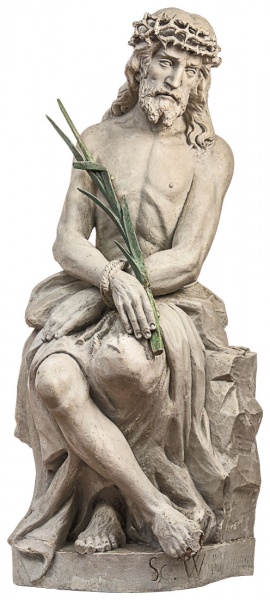
Ecce Homo (Christ Mocked)
| Author: |
Wincent Bałzukiewicz (1835–1907) |
| Created: | second half of the 19th century |
| Material: | wood |
| Technique: | carving, colour paint |
| Dimensions: | 114 cm |
| Signature: | on the base: Sc. W. Bałzukiewicz |
This sculpture portrays Christ in anguish, sitting half naked, after being scourged and mocked by his executioners, with a crown of thorns on his head and a reed in his bound hands. The episode is described in the Gospel: ‘Then Pilate took Jesus and had him flogged. The soldiers twisted together a crown of thorns and put it on his head. They clothed him in a purple robe and went up to him again and again, saying, “Hail, king of the Jews!” And they slapped him in the face’ ( Jn 19, 1–4). Later, Jesus was brought before the crowd, and Pilate said: ‘Ecce Homo’ (Behold the man). This is part of the Passion, and is interpreted profoundly in European art. Jesus is portrayed as being mocked and beaten by his torturers, or as alone, downcast and in pain after the torture. Pictures of the mockery of Jesus were usually included in the Stations of the Cross. Sculptures were put in chapels of the Calvary, representing the jail in Pilate’s palace. Wincent Bałzukiewicz (1835–1907) from Vilnius made this sculpture with a Baroque composition and form: the symbolically crossed hands and feet are the traditional posture for the figure. The back of the sculpture is not modelled; the composition is frontal, and therefore the sculpture Ecce Homo probably stood in a niche, maybe on an altar.
Text author Dalia Vasiliūnienė
Source: Law firm Valiunas Ellex art album HEAVEN AND BEYOND (2016). Compiler Dalia Vasiliūnienė. Text authors Dalia Vasiliūnienė, Skaidrė UrbonienėExpositions: “Heaven and Beyond. Works of religious art from the collection of Rolandas Valiūnas and the law firm Valiunas Ellex“, 31 May–24 September 2016, Church Heritage Museum, Vilnius (curators Dalia Vasiliūnienė, Skaidrė Urbonienė)







